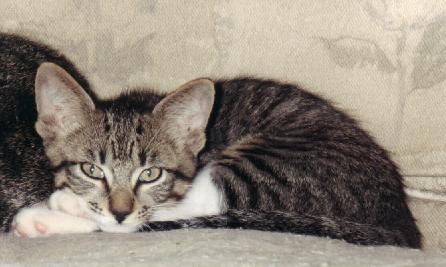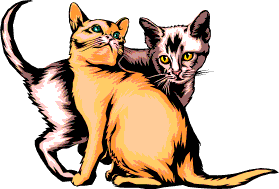The Evolution &
History of the
Domestic Cat
|
|
Please Help Pets with a Small Gift of Only One Dollar
Cat Evolution Part 1
By Alfred
It has long been scientifically accepted that the house cats
that we know and love today have wild ancestors: Cousins
that used to roam the plains indiscriminately hunting,
breeding and living without the aid or care of humans. Just
recently it has been determined that the ancestor from which
all cats originated is actually a wild cat from the Fertile
Crescent, not Asia like it was originally thought.
The Fertile Crescent is located in the Middle East,
specifically, Saudi Arabia, Israel and other neighboring
countries. The Near Eastern Wildcat still exists today and
roams the deserts in those countries just as it has for
thousands of years. The belief is that seventy thousand to
one hundred thousand years ago, the Near Eastern Wildcat was
the progenitor of the domestic house cat of today.
"It's plausible that the ancient [domestic cat] lineages
were present in the wildcat populations back as far as
70,000 or 100,000 years ago," said study co-author Stephen
O'Brien of the National Cancer Institute in Frederick,
Maryland.
The wildcat kittens may have been originally found by
farmers, tamed and allowed to roam the farm to hunt for
pests that would damage crops.
"One of nearly 40 wild cat species existing at that time,
the little wildcat that lived in the Middle East had a
genetic variance that allowed it to sort of try an
experiment - 'let's walk in and see if we can get along with
those people'," O'Brien said.
Carlos Driscoll of the National Cancer Institute, scientists
at the University of Oxford in England, and others have
studied the cat and its lineages and have found five
matriarchal lineages to which modern domestic cats belong.
"This tells us that domestic cats were sort of widely
recruited, probably over time and space," Driscoll said.
See The Evolution of
the Cat - Part 2
The Cat Fanciers' Association was founded in 1906 and is
dedicated to promoting the welfare of domestic cats and
improving the breeds. A nonprofit organization that registers
the pedigrees of cats and kittens, the CFA and its affiliates
also sponsor over 400 cat shows annually worldwide.
In addition, in 1968 the CFA established the Winn Feline
Foundation, which has donated over two million dollars
toward medical research to improve the health of all cats.
After reading about the history of the cat,
Dragon Cat thinks it's time to take a well deserved nap.

The Cat Fanciers' Association currently recognizes 36
breeds of domestic cats.
You will find detailed information about each of these
breeds of cats, on our Cat Breeds page.
Abyssinian
American Curl
American Shorthair
American Wirehair
Balinese
Birman
Bombay
British Shorthair
Burmese
Chartreux
Colorpoint Shorthair
Cornish Rex
Devon Rex
Egyptian Mau
European Burmese
Exotic
Havana Brown
Javanese
Japanese Bobtail
Korat
Maine Coon
Manx
Norwegian Forest Cat
Ocicat
Oriental
Persian
Russian Blue
Ragdoll
Scottish Fold
Selkirk Rex
Siamese
Singapura
Somali
Tonkinese
Turkish Angora
Turkish Van

Once upon a time in the history of the domestic
cat, they were pretty much left on their own to
fend for themselves.
Back then if they didn't hunt for their food, they
didn't eat. So cats developed some pretty good hunting
skills.
In today's society, many cats don't go out and
hunt for their food, instead their pet parent goes
out to K-mart or Krogers and "hunts" for their
food in the supermarket pet food isle.
The problem with almost all supermarket foods is
that they don't have a real long shelf life, but
unfortunately the big cat food manufacturers make
tons and tons of the stuff where it sits in whare houses
all over the country for up to a year or more before
it's even shipped to the store.
The reason why is that they buy corn on the futures
market and then take delivery of truckloads of corn
at a time when the price is most favorable to them.
If corn goes up, they don't have to buy because
they've got plenty of corn in storage and bags of
cat food on their shelves.
That causes a lot of food to go rancid and if your
kitty eats it, then before long you have digestive problems
at the least and your wondering what's wrong with
kitty cat.
The food that Alfred and his buddies here eat is
manufactured in the United States, doesn't contain
corn, and is almost always sold to the consumer within
1 month of baking.
You've got to take a look at this food, and get your
kitty some free samples of cat food while your there.
Kitty Cat Food - as Fresh as Fresh
Can Be
|